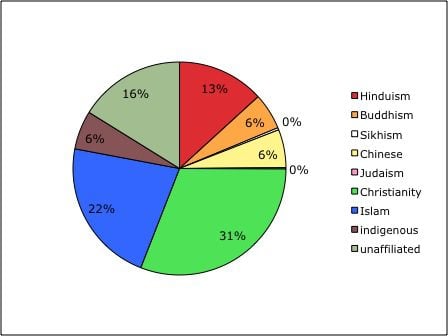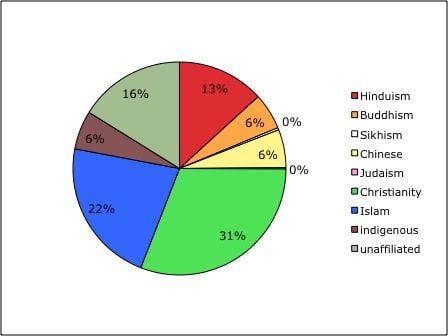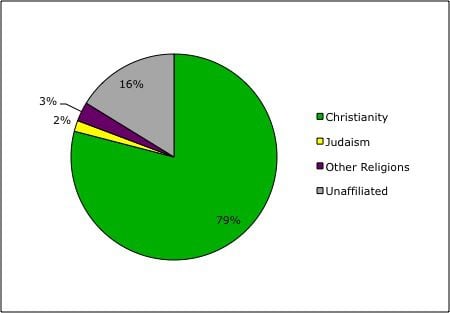Out of a total world population currently close to seven billion people, the global religious “pie” slices up roughly as follows:
The above raw data calls for at least a little bit of additional explanation and commentary.
The clear winner, in terms of sheer size, is Christianity, coming in with nearly one-third of the world’s total population. Note, however, that “Christianity” as a category includes Roman Catholics, Eastern Orthodox of all sorts (Greek Orthodox, Russian Orthodox, etc.), and Protestants of all sorts (from mainline denominations such as Baptist, Methodist, Lutheran, Presbyterian, and Episcopalian, to Jehovah’s Witnesses, Seventh-Day Adventist, Amish, Mennonite, Quaker, Mormon, non-denominational, etc.).
If that Christian slice of the global religious pie was subdivided graphically to display all of that internal Christian diversity, then fully half of the Christian pie-slice would be Catholic; the other half would be “miscellaneous” (everything else that goes by the label “Christian”).
The second-largest slice of the global religious pie belongs to Islam. And the size of that particular slice may be growing, relative to all of the other slices. Some observers have stated (although other sources have disputed this) that Islam is currently the fastest-growing religion in the world, and that if present growth rates continue, Islam will surpass Christianity in size at some point later this century, making Islam the world’s largest religion. If this happens, then of course the global religious pie will have to be redrawn, with Islam getting the biggest single slice.
What some may find a bit surprising is that third place, in this ranking of total world religious affiliations by their relative sizes, belongs to the religiously unaffiliated. “Unaffiliated” here means both those who claim no religious beliefs or affiliations whatsoever (atheists, agnostics, secularists, nonbelievers), as well as those who may hold private religious beliefs or pursue independent spiritual paths of their own, unaffiliated with any particular specific religion (many of the “spiritual but not religious” types may fall under this category). Both categories have been lumped together here, as both are indeed “unaffiliated,” albeit in different senses.
Coming in at number four is Hinduism, the world’s third largest religion (since “unaffiliated,” despite holding the number three spot, is itself a mixed bag and not really “a religion” per se). Although pockets of Hindus can be found worldwide, by far the vast majority still live in India, their home country. In addition to India, Hinduism is also the majority religion in Nepal and Bali (in Indonesia).
In a dead heat with each other for numbers five and six are Buddhism and the category of Chinese religions. And this is where things start to get a little hazy, because there is considerable fuzzy overlap between the two. Buddhism is one of the three main Chinese religions (the other two being Confucianism and Taoism), but it also exists independently as a major religion of its own, beyond China (Buddhism is the majority religion of Japan, Korea, Tibet, Sri Lanka, Burma, Laos, Cambodia, and Thailand). Complicating things even further is the fact that, in China, one can be a Buddhist, a Taoist, and a Confucian, all at the same time. So, how does a survey taker conduct an accurate head count?
Slot number seven goes to the broad category of indigenous religions. These are the religions of the indigenous and often non-literate societies of the world, of the various widely-separated tribal cultures that are scattered around the globe. This is not one religion, but many — Australian aboriginal, Native American, African tribal, Inuit (Eskimo), Pacific Islander, and so forth. Though widely scattered, many indigenous religions seem to frequently share certain commonly recurring features, such as animism (the belief that everything in nature is alive, with even seemingly inanimate objects possessing a spirit or soul) or shamanism (the belief that certain individuals known generally as a shaman, has the power to enter a trance and make an inward journey into the spiritual realm on behalf of his human community, to heal or to solve other problems).
Just because a tiny pie slice has a “0%” next to it does not mean that there are literally zero adherents of the religions represented by those slivers. Here, “0%” just means “less than one percent.” That figure applies to both Judaism and Sikhism. Considering the sheer magnitude of their significance upon the global religious scene, as well as their central importance throughout thousands of years of Western religious history, many readers may be surprised to discover that Jews account for less than one percent of the total human population. Yet such is the case. Many may also be surprised to discover that Sikhs — followers of a similarly small Eastern religion that many Americans seem never to have even heard of — actually outnumber Jews.
Other religions exist, of course (from Jainism and Zoroastrianism, to Shinto and Wicca, to Baha’i and Rastafarianism and Scientology, and many more), but at levels that are likewise generally too small to register on a graphical pie chart such as this one.
This, however, is pretty much how the major faith traditions of the world break down, when seen from a comprehensive global perspective.


